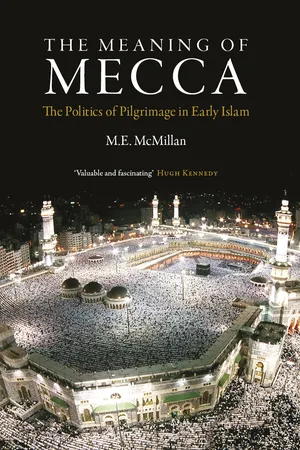![]()
ONE
The Prophet’s Precedent: The Farewell Ḥajj of 10/632
THE PROPHET AND THE PILGRIMAGE
In 10/632, the Prophet Muḥammad left Medina to return to Mecca to perform what Islamic tradition would remember as the Farewell Pilgrimage, the Ḥijjat al-Wadā‘.
Only ten years earlier, Muḥammad had been forced to flee his home city in the dead of night, his life in danger because of the prophetic mission he refused to give up. But the intervening decade had brought him a level of success that allowed him – almost uniquely in history – to be recognized as a Prophet in his own country.
Muḥammad’s goal in Mecca was to perform the ḥajj. The city was an ancient cultic centre and the Ka‘bah had long been home to a pantheon of pagan idols revered by Arab tribes throughout the peninsula.1 Four months of the year were set aside for pilgrimage: the spring month of Rajab for the lesser pilgrimage known as the ‘umrah and the last two months of the year and the first of the new year for the main pilgrimage or ḥajj.2 Raiding amongst tribes ceased during these months and many of them took advantage of their time in Mecca to engage in trade.3 Over the years, the city’s economy had become so closely linked with this commercial activity that fear of losing it lay behind much of the opposition to Muḥammad and his new religion.
The Farewell Pilgrimage saw Muḥammad reinforce the centrality of Mecca as a cultic centre but shift the spiritual focus away from the multitude of pagan gods towards the One God – Allāh. He also set about returning the ḥajj to what he believed were its true origins.4 According to Muslim sacred history, it was Ibrāhīm (Abraham) and his son Ismā‘īl (Ishmael) by the bondswoman Hajar who originally built the Ka‘bah.5 When they finished, Ibrāhīm received divine instructions not to associate any gods with God and to proclaim pilgrimage to the Sacred House.6
Muḥammad saw himself as the restorer of this message and in Mecca in 10/632 he, too, proclaimed pilgrimage to the Sacred House.7 At ‘Arafāt, just outside the Holy City, he delivered a sermon in which he explained the rituals of the pilgrimage and where they were to be done.8
He joined the lesser pilgrimage, the ‘umrah, with the main pilgrimage and abolished the intercalary month to make the Islamic year lunar.9 As the lunar year is eleven days shorter than the solar year, the ḥajj falls earlier each year and, over a thirty-year cycle, rotates through all four seasons. The abolition of the intercalary month thus placed the Islamic pilgrimage outside the cycle of the seasons. This break with the past left no room for ambiguity about the meaning of the new ḥajj: it was an act of worship directed to God, and only God, not a celebration of nature or a god of nature.10
Rather ominously during his sermon, the Prophet warned his listeners to pay careful attention to what he was saying because he did not know if he would ever be with them again in Mecca.11 Days later, on his way home to Medina, he fell ill and died soon afterwards.
The Farewell Pilgrimage is an important part of Islamic sacred history. Western scholarship has, however, questioned whether the rituals of the pilgrimage were finalized at that time or whether this process occurred over a much longer period.12 Attempts to understand the historical development of the ḥajj are further complicated because the accounts we have of Muḥammad’s life and religious mission were written over a century after his death; a time delay which has provoked considerable – and often impassioned – debate over their likely reliability.13
As well as tracing the development of the pilgrimage, scholars have also sought to find a historical context for the rites performed during it. Some see traces of stone worship, pre-Islamic pagan practices, or the influence of Judaism in the rituals of the ḥajj.14 Others have interpreted them as independent developments originating within Arab-Islamic culture.15
The origins of the rituals may never become fully clear. And perhaps the last word on the subject should go to the great philosopher al-Ghazālī who declared that, for Muslims, the ḥajj stands beyond explanation. Like Islam itself, it is a willing act of submission to God. God commands it, therefore it is done.16
THE RITUALS OF THE ḤAJJ17
Day 1: Dhū al-Ḥijjah 8
The ḥajj takes place in Dhū al-Ḥijjah, the twelfth – and final – month of the Islamic year and lasts for six days: from the 8th to the 13th.18
The first day is known as Yawm al-Tarwiyah, the day of quenching.19 On this day pilgrims enter the state of ritual purity, iḥrām, and declare their intention, niyyah, to perform the ḥajj.
The state of iḥrām places a number of obligations on pilgrims which are aimed at focusing their attention on the internal and the spiritual rather than the external and the secul...
